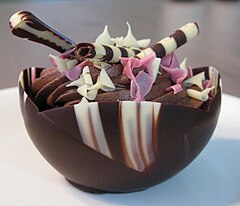
Edible tableware is tableware, such as plates, drinkware glasses, utensils and cutlery, that is edible. [1] Edible tableware can be homemade [2] and has also been mass-produced by some companies, and can be prepared using many various foods.

Edible tableware is tableware, such as plates, drinkware glasses, utensils and cutlery, that is edible. [1] Edible tableware can be homemade [2] and has also been mass-produced by some companies, and can be prepared using many various foods.
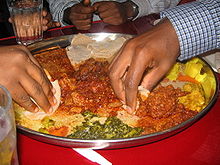
Edible tableware can be homemade or mass-produced, and is prepared from various foods. [2] For example, homemade tableware can be fashioned using sliced celery as chopsticks, and celery can also be used to scoop foods such as dips and cream cheese. [3] A leaf of cabbage can be used as a spoon, and a carrot stick that has been sharpened can be used as a skewer. [2] Edible bowls and plates can be prepared with many methods. Bread which has had its center removed can be used for soups, and similarly, baking cheese in an oven and forming the cheese into the desired shape. [4] Chocolate can also be fashioned into edible tableware. [lower-alpha 1]
Flatbread such as khobez is sometimes used as an eating utensil, such as when it is used to scoop hummus, and Ethiopian injera bread is used as a utensil to scoop wat. [6] In West Africa, flatbread is sometimes used to scoop fufu for consumption. [6] In India, chapati flatbread is used as a utensil to consume sambar and dal. [7] In North and Central America, the tortilla is used as a utensil to scoop various foods such as salsa and bean dips. [8] Foods such as crackers, corn and tortilla chips, crudités, bread and cheese sticks can also be used as edible utensils. [9] [10] [11]
Edible tableware such as cups, bowls, plates and platters prepared using sugar paste have been in use since at least the Elizabethan era and edible tableware was considered as a sign of wealth. [12] In 1562, a recipe for edible tableware and cutlery, such as knives, forks, chopsticks and spoons, was published by Alexius Pedemontanus. [1]

Pita or pitta is a family of yeast-leavened round flatbreads baked from wheat flour, common in the Mediterranean, Levant, and neighboring areas. It includes the widely known version with an interior pocket, also known as Arabic bread. In the United Kingdom, Greek bread is used for pocket versions such as the Greek pita, and are used for barbecues as a souvlaki wrap. The Western name pita may sometimes be used to refer to various other types of flatbreads that have different names in their local languages, such as numerous styles of Arab khubz (bread).
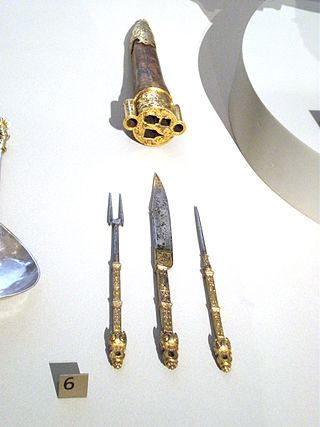
Cutlery, includes any hand implement used in preparing, serving, and especially eating food in Western culture. A person who makes or sells cutlery is called a cutler. The city of Sheffield in England has been famous for the production of cutlery since the 17th century and a train – the Master Cutler – running from Sheffield to London was named after the industry. Bringing affordable cutlery to the masses, stainless steel was developed in Sheffield in the early 20th century.
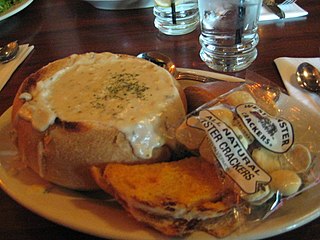
A bread bowl is a round loaf of bread which has had the top cut off and a large portion of the middle hollowed out to create an edible bowl. They are typically larger than a roll but smaller than a full sized loaf of bread.

Lavash is a thin flatbread usually leavened, traditionally baked in a tandoor or on a sajj, and common to the cuisines of South Caucasus, West Asia, and the areas surrounding the Caspian Sea. Lavash is one of the most widespread types of bread in Armenia, Azerbaijan, Iran and Turkey. The traditional recipe can be adapted to the modern kitchen by using a griddle or wok instead of the tonir.

Various customary etiquette practices exist regarding the placement and use of eating utensils in social settings. These practices vary from culture to culture. Fork etiquette, for example, differs in Europe, the United States, and Southeast Asia, and continues to change. In East Asian cultures, a variety of etiquette practices govern the use of chopsticks.

Tableware items are the dishware and utensils used for setting a table, serving food, and dining. The term includes cutlery, glassware, serving dishes, serving utensils, and other items used for practical as well as decorative purposes. The quality, nature, variety and number of objects varies according to culture, religion, number of diners, cuisine and occasion. For example, Middle Eastern, Indian or Polynesian food culture and cuisine sometimes limits tableware to serving dishes, using bread or leaves as individual plates, and not infrequently without use of cutlery. Special occasions are usually reflected in higher quality tableware.
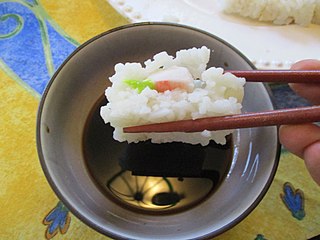
A dip or dip sauce is a common condiment for many types of food. Dips are used to add flavor or texture to a food, such as pita bread, dumplings, crackers, chopped raw vegetables, fruits, seafood, cubed pieces of meat and cheese, potato chips, tortilla chips, falafel, and sometimes even whole sandwiches in the case of jus. Unlike other sauces, instead of applying the sauce to the food, the food is typically placed or dipped into the sauce.

Table manners are the rules of etiquette used while eating, which may also include the use of utensils. Different cultures observe different rules for table manners. Each family or group sets its own standards for how strictly these rules are to be followed.

Pimento cheese is a spread most popularly made of cheese, mayonnaise, and pimentos and served on crackers and vegetables or in sandwiches. A favorite of the cuisine of the Southern United States—it has been referred to as the "pâté of the South" and "the caviar of the South."—it also is enjoyed elsewhere, with regional variations in ingredients.

A flour tortilla or wheat tortilla is a type of soft, thin flatbread made from finely ground wheat flour. Made with flour- and water-based dough, it is pressed and cooked, similar to corn tortillas. The simplest recipes use only flour, water, fat, and salt, but commercially-made flour tortillas generally contain chemical leavening agents such as baking powder, and other ingredients.
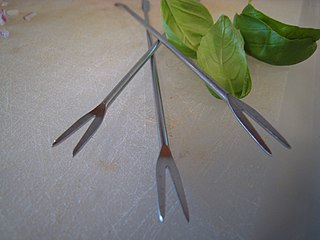
A lobster pick or lobster fork is a long, narrow food utensil used to extract meat from joints, legs, claws, and other small parts of a lobster. Lobster picks are usually made of stainless steel and weigh as much as an average teaspoon. They have a long, textured cylindrical handle, ending in a crescent-shaped moderately sharp pick, or else a small two-tined fork. A three-tined version has a longer central tine with two shorter side tines with hooks on them. The other end may have a spoon for scooping out meat from inside the lobster. The lobster pick can also be used with other seafood, such as crab and crawfish.

Cheese soup is a type of soup prepared using cheese as a primary ingredient, along with milk, broth and/or stock to form its basis. Various additional ingredients are used in its preparation, and various types and styles of cheese soup exist. It is a part of some cuisines in the world, such as American, Colombian, Mexican, Swiss, French, and Tibetan cuisines. Mass-produced cheese soups may be prepared with the addition of food additives to preserve them and enhance flavor. A list of cheese soups is included in this article.

Bean dip is a type of dipping sauce made using beans or refried beans as a primary ingredient. It is typically served with tortilla chips, and can also be served with other foods such as crackers and crudités. Various types of beans are used, and fresh-cooked, canned or flaked beans can be used. Various additional ingredients are used in its preparation, such as onion, garlic, chili peppers and spices, and it is sometimes garnished with some ingredients. Bean dip can be served cold, at room temperature, or hot. Bean dip is sometimes used as an ingredient in the preparation of other dishes such as burritos and quesadillas.

Crab dip, sometimes referred to as Maryland crab dip, is a thick, creamy dip that is typically prepared from cream cheese and lump crab meat. Other primary ingredients such as mayonnaise may be used. Various types of crab preparations, species and superfamilies are used, as are a variety of added ingredients. It is typically served hot, although cold versions also exist. Hot versions are typically baked or broiled. It is sometimes served as an appetizer. Accompaniments may include crackers and various breads. Some U.S. restaurants offer crab dip, commercially produced varieties exist, and some stadiums offer it as a part of their concessions.

Acquacotta is a hot broth-based bread soup in Italian cuisine that was originally a peasant food. Its preparation and consumption dates back to ancient history, and it originated in the coastal area known as the Maremma in southern Tuscany and northern Lazio. The dish was invented in part as a means to make hardened, stale bread edible. In contemporary times, ingredients can vary, and additional ingredients are sometimes used. Variations of the dish include acquacotta con funghi and acquacotta con peperoni.
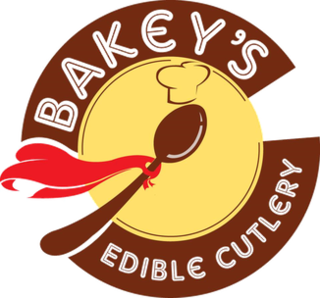
Bakeys is an Indian edible cutlery manufacturing startup company based in Hyderabad, Telangana. Bakeys was founded in 2010 by former ICRISAT researcher Narayana Peesapaty as an eco-friendly alternative to disposable utensils prepared with plastic, wood and bamboo, such as bamboo chopsticks.

Watercress soup is a soup prepared using the leaf vegetable watercress as a primary ingredient. It may be prepared as a cream soup or as a broth/stock-based soup using vegetable or chicken stock. Additional ingredients used can include vegetables such as potato, leeks, spinach, celery and turnips, cheese, butter, lemon juice, salt and pepper. Watercress soup can be prepared as a puréed soup by mixing the ingredients in a food processor. It can be served hot or cold, and may be garnished with crème fraîche, shaved Parmesan cheese, drizzled olive oil and watercress leaves.